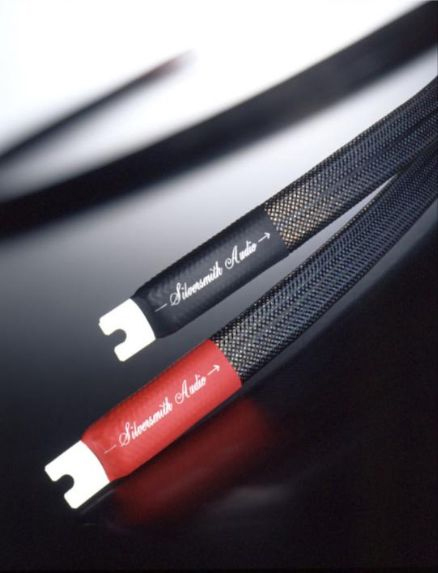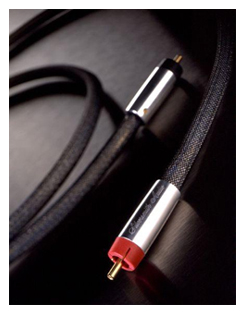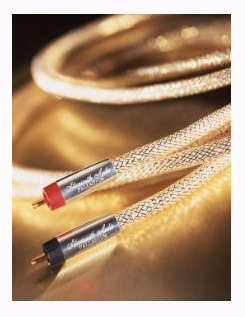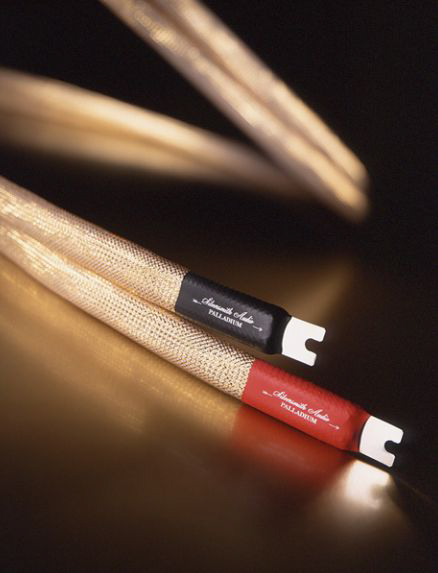
You are reading the older HTML site
Positive Feedback ISSUE
42march/april 2009
silversmith cables
Audio Precision + Musical Glory - Not for the Faint of Heart
as reviewed by Jim Merod

|
JIM MERODS' SYSTEM
LOUDSPEAKERS
ELECTRONICS
SOURCES
CABLES
ACCESSORIES
|
Music In the Palm of Your Grasp
Jeffrey Smith, CEO at Silversmith Cables and head hound dog of the remarkable Dodson D/A conversion units, is a generous fellow. On numerous occasions over the last several years, Maestro Smith has hauled his state-of-the-art Palladium as well as his Silver cables north from San Diego so I might use his virtually unrivaled wire in live "on location" recordings. The roundtrip mileage covered is not inconsiderable. My appreciation equals my admiration for Silversmith cables.
None of this of course, would promote more than a life-affirming moment of sentimental zeal if the outcome of such deliveries were not ear opening. The simple fact at the heart of Silversmith wire is an extreme dedication to art—the design and manufacturing of strong, aesthetically elegant cables; blindingly fast, rigorously accurate metal; the refusal to emulate current cable-plating tactics; and insistence upon signal precision and audio resolution of the highest possible order.
Probably the most startling demonstration of these collected features occurred the first time Roberta Piket's world class trio flew west from their New York base for gigs up and down California. Roberta is an adventurous, highly lyrical pianist. During our time together on two separate west coast jaunts, her companion and percussionist, the iconoclastic Billy Mintz, locked in perfectly with bassist Ratso Harris… their magic in no small part a product of Silversmith cables placed in the web and woof of Maestro Harris' bass set up.
 Here's the kicker.
During sound check on the first of the two dates we recorded, I
encouraged our resident bass guru to swap his standard cable—from his
bass pick up to his amplifier cabinet—or a Silversmith Palladium
cable. Bemused, with little apparent expectation of useful results,
Ratso Harris went along with my suggestion only (voila!), at the very
first strum of his instrument, to be amazed by the sonic difference.
Trust me, it was not a small nuance but a boomingly clear, utterly
resounding bass note that shot through his strings, pick up, and
amplifier.
Here's the kicker.
During sound check on the first of the two dates we recorded, I
encouraged our resident bass guru to swap his standard cable—from his
bass pick up to his amplifier cabinet—or a Silversmith Palladium
cable. Bemused, with little apparent expectation of useful results,
Ratso Harris went along with my suggestion only (voila!), at the very
first strum of his instrument, to be amazed by the sonic difference.
Trust me, it was not a small nuance but a boomingly clear, utterly
resounding bass note that shot through his strings, pick up, and
amplifier.
Ratso roared "whoa," as he turned to me (my headphones restraining that blast) to note the vast transformation. Succinctly rendered, Ratso Harris' bass sound was revolutionized. Its expressive voice enlarged in size, articulation, complexity and fullness—as if he had swapped bass instruments, going from a modestly nice sonic delivery to a different universe of sound altogether.
I cannot overstate how surprised and pleased this wonderful bassist was… nor can I overstate my own delight to have the bottom end of the recording chain so firmly, brilliantly rendered from the lowest note to its upper bass registers—surprisingly higher in the sonic spectrum than most listeners and many recording engineers are aware of.
If a single one meter Silversmith cable can cause such gorgeous havoc, imagine how pleased the trio was to hear their own playing greatly more delineated in their monitors during each of the four hour-plus sets we recorded. The long and short of these roaringly delicate, powerfully nuanced cables come to this. For "on location" recording work, nothing is more supportive of the hard work to overcome sonic gremlins and untamed signal bleed than such astonishing signal quickness, precision and spectral fullness.
Unabated Angelic Choirs
If I could afford
Silversmith's Palladium cables, I'd tuck them permanently in my
bag of recording gear and haul them everywhere I trek. The interim
solution ain't bad: Jeffrey Smith's generous willingness to lend them to
an old guy who truly loves their "recording friendly" audio-enhancing
character. The unstated discrimination here is to approximate the sonic
difference encountered between Silversmith's "silver" cables and its "palladium" cables.
I've used these cables as (very) expensive microphone wires and patch cords for quite a long time. I can sincerely attest to the fact that they are among the best cables I've worked with—in sum, among a group of not more than three. But that does not truly tell the deep story of their unique ability. Stealth's Indra cables have a fantastic ability to remove themselves completely from the signal delivery path. Their "sonic footprint" is essentially invisible, inaudible, and not in any way discernible.
Kubala-Sosna's Emotion cables render instruments with full-bodied richness of tone and verisimilitude (an old fashioned word that indicates accuracy of representation), with warm sonic clarity that captures the heart of an instrument's physical embodiment. Both of these extraordinary cables are glorious. Differences between them are real but compellingly perplexing: recorded voices and instruments are neither deformed nor denigrated by their inclusion in the recording matrix, even though a subtle distinction between them is clearly evident—to one's curiosity and delight.
Silversmith's Silver wire is lightning quick, as if the micro-second elapsed during signal transfer is so short that no distortion or diminishment can occur. Silversmith's Palladium wire is no less quick but carries even more sonic information—a virtue that stands at the crossroads between musical glory and a listener's caution since, for a recording engineer, one can never receive enough musical information while, from a listener's more protected position, vast degrees of sonic data can be distracting. From the vantage of commercially-rendered (prophylactic, well protected) recordings, the drunk woman asking for another bottle of beer at the bar or the unsuspecting fellow flushing a toilet in the men's room are threats to conventional listening joy. Feint-hearted audio engineers may not want such all-revealing cables in their signal chain. I do, since (a) these cables are both refined and sonically precise; and (b) you can take sonic and musical information out of a recording mix, but you cannot add back what's not captured in the first place.

Waiting for the Fat Lady to Croon
Do not misinterpret what I'm stating here. These comments are not back-handed compliments. They are not offered as ambivalent praise. On the contrary, I mean to say—as clearly as I can—that most audiophiles and casual music lovers never get as close to music as the engineers who record it. Many listeners are put off by "too much" sonic information. In sum, for anyone who counter-intuitively seeks to become as intimate with an original performance as possible, such naked signal reception and music transfer may arrive with the lyrical flutter of angelic wings or with the thud of unexpected sonic overload. Silversmith cables bring you everything. Caveat emptor! Touché! Ignorantia juris neminem excusat.
All the cables I've named capture "truthful" instrumental and vocal sound within a Plank-scale reach of one another. Pragmatically, differences between them are subtle, essentially minute, and almost negligible (a matter of personal temperament and taste for the most part). The "Indra" is leaner than the "Emotion" which, in turn, is a skosh less quick than both Silversmith cables. The ultimate impact, from the recording bloke's point of view is defined quite literally by the number of cables of each kind one employs on a single recording.
I once had the significant honor to make an all Kubala-Sosna (mostly "Emotion") recording—with Kenny Barron, Buster Williams and Lenny White—now released as a BluePort album (BP-J019). I've never had the opportunity to record with numerous "Indra" cables in the cumulative signal path, though I've been able on occasion to cobble together enough Stealth cables of various designs and iterations to accomplish an essentially "all Stealth" live recording. Thanks to Jeffrey Smith's frequent, welcome trudge to loan his superior wire for recording use, I've had the chance to make a number of "all Silversmith (Silver and Palladium) cable" recordings, one at least of which is over-determined with hilarious solicitation "requesting" to be published for the delight of jazz audiophiles.
At the end of the song (concluding the plump gal's screeching): you should hear the tonal brilliance and near hologrammic three-dimensionality of Geoff Keezer's Trio—with Christian McBride, bass, and Terreon Gully, percussion… one of the world's greatest jazz trios captured at the height of audio clarity and creative inspiration. Missing that, try drummer extraordinaire Roy McCurdy's world class trio (Llew Mathews on piano and John Belzaguy on bass. Seriously happy music, seriously deep sound, and serious perfection all ‘round.
Concordat
I'm often struck, as today reading the new Stereophile "Recommended Components" issue, with the intransigence of its listings. For example, no Silversmith cable is found there, though they once were on the list. Ditto Kubala-Sosna's Emotion and Expression cables. And Stealth's Indra and Nanofiber have been deleted because they've not been reviewed in a long while. Egad. Why not overlook the venerable Linn LP-12 turntable on the grounds of geriatric-hood?
Honest critically-acute people differ about many things… perhaps all things worth assessing and savoring. But as a cable-alert person, I find a bitter truth in this fact: an audio cable's absolute value sonically is imperfectly reflected in the price attached to its market cost. This is for me, Darwin's First Law of High-end Audio Reality. The cables I've come to rely on most, and trust as relative "absolutes" in my recording and mastering world, are expensive. But other cables that I've not named, and find to be off the mark sonically, are equally expensive—and in some absurd instances far more expensive. Snake oil was once a staple of the Wild West's dusty street marketplace. Snake oil takes on somewhat different packaging in the contemporary world. Do you know someone who'd like to invest in my Guaranteed "Can't Miss" Bundled Derivatives? I'll give ‘em a fair deal.
My version of the Large Woman Warbling at concert closing comes to this. My ruminations about "the best" audio cables on earth have shifted over time because new cable designs appear, new materials, new creators, and even (alas!) new audio recording uses—about this fact, more down the road—but one element remains constant. The brute delicacy of the best signal transfer is open, full-bodied, and timbrally nuanced. It presents a "you are there" listening moment: complex sound recorded with enormous represented by superior playback with equally complex accuracy—beautifully, convincingly, and seductively.
I have more to say about Silversmith cables as well as Jeffrey Smith. His not to be denied (one of a kind) custom made home sound system and his knock-out Dodson unit. I'll defer those observations and conclude simply but directly Kubala-Sosna cables have made an extraordinary impact on the audiophile market in a very short time. In my decades of attention to the high-end, I've never witnessed anything quite like their rise from start up to top of the pack boogie dancing. A good many serious listeners, the hip audio cognoscenti, are well aware of Stealth cables, no less. But, along with those two cable champions, lauded here with loving care at BluePort Jazz, Silversmith Cables deserve long-overdue inclusion in the small circle of Rolls Royce Cable Performance.
I know as well as anyone how much an audiophile's cable preference depends upon associated equipment. I'm not unaware when it comes to differences of taste and audio temperament, as well. But I'm also alert that, when a cable performs at the top of the top with a wide variety of associated gear, something extraordinary sonically is involved. Consider Silversmith Palladium and Silver cables to reside on an audio short list that Buddha, Nostradamus and doubtless Herbie Hancock would request as an Easter gift or year-end reward for good deeds. If you've got the bucks in this current economic downturn to buy Lagavullin 16 or Macallan's 18, you're probably eligible to slake your deepest audio thirst with cables as awe-inspiring as Silversmith's. If you don't try them, you'll never know their exquisitely-refined sonic pedigree. Jim Merod
Silver speaker cables (6' pair) and
Silver interconnects (3' pair)
Retail: $2500 and $1400, respectively.
Palladium speaker cables (6' pair) and
Palladium interconnects (3' pair)
Retail: $9800 and $4000, respectively.
Silversmith
web address:
www.silversmithaudio.com

